1988 PONTIAC FIERO bulb
[x] Cancel search: bulbPage 942 of 1825
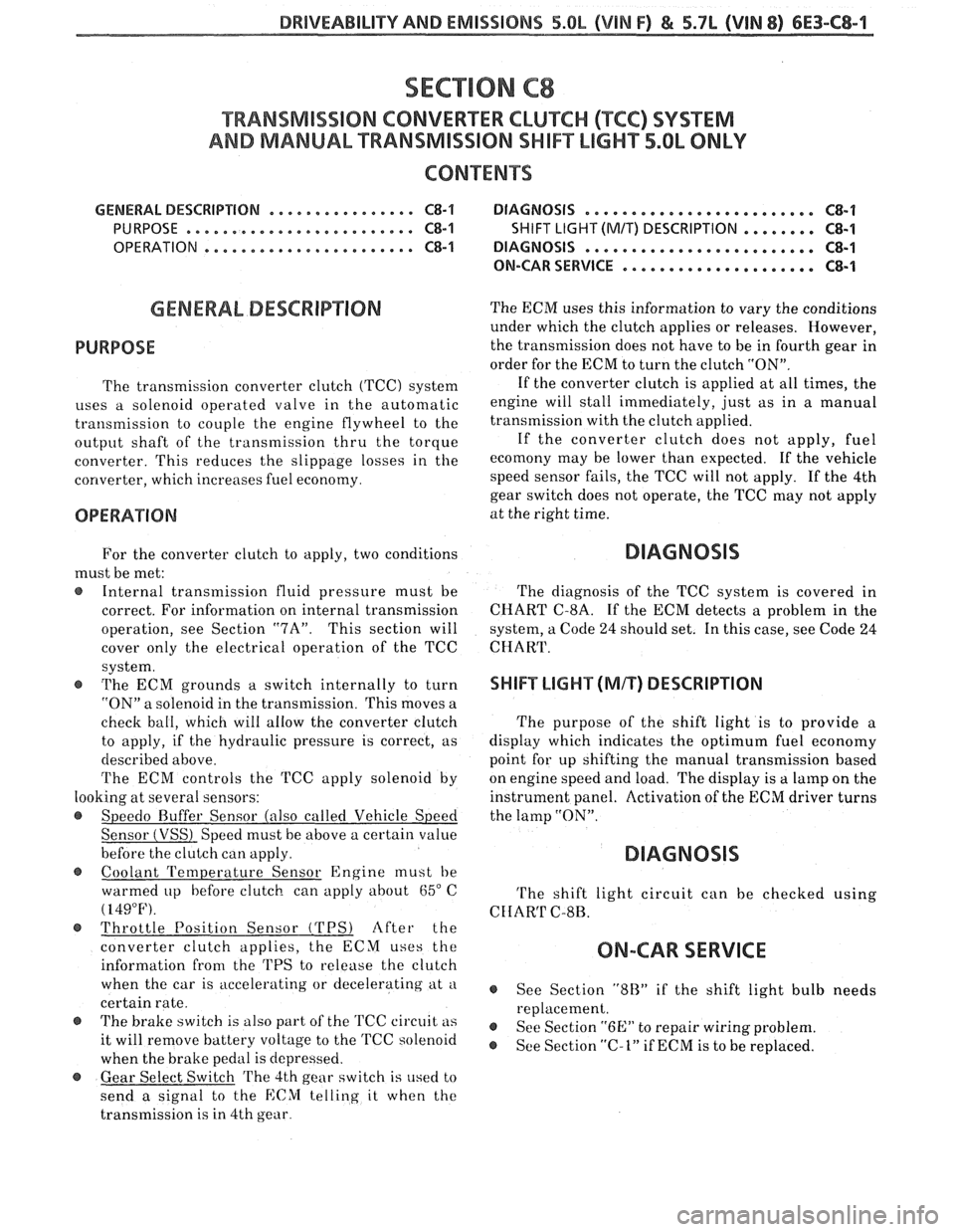
DWlVEABlLlTV AND EMISSIONS 5.01, QVIN F) & 5.71 (VIN 8) 6E3-C8-1
TRANSMISSION CONVERTER CLUTCH (KC) SYSTEM
AND MANUAL "TRANSMISSION SHlFT LBGH"O"=Ob ONLY
CONTENTS
................ GENERAL DESCRIPTION C8-1 DIAGNOSIS ....................... .. C8-1
........ PURPOSE ......................... CS-1 SHIFT LIGHT (MIT) DESCRIPTION C8-1
....................... OPERATION C8-1 DIAGNOSIS ......................... CS-1
OM-CAR SERVICE ..................... C8-1
GENERAL DESCRIPTION
PURPOSE
The transmission converter clutch (TCC) system
uses
a solenoid operated valve in the automatic
transmission to couple the engine flywheel to the
output shaft of the transmission thru the torque
converter. This reduces the slippage losses in the
converter, which increases fuel economy.
OPERATION
For the converter clutch to apply, two conditions
must be met:
e Internal transmission fluid pressure must be
correct. For information on internal transmission
operation, see Section
"7A". This section will
cover only the electrical operation of the TCC
system.
@ The ECM grounds a switch internally to turn
"ON" a solenoid in the transmission. This moves a
check ball, which will allow the converter clutch
to apply, if the hydraulic pressure is correct, as
described above.
The ECM controls the TCC apply solenoid by
looking at several sensors:
@ Speedo Buffer Sensor (also called Vehicle Speed
Sensor
(VSS) Speed must be above a certain value
before the clutch can apply.
@ Coolant Temperature Sensor Engine must be
warmed
LIP before clutch can apply about 65" C
(149°F).
Throttle Position Sensor (TPS) After the
converter clutch applies, the ECM uses the
information
from the TPS to release the clutch
when the car is accelerating or decelerating at
a
certain rate.
The brake switch
is also part of the 'I'CC circuit as
it will remove battery voltage to the
'FCC solenoid
when the brake pedal is depressed.
@ Gear Select Switch The 4th gear switch is used to
send a signal to the ECM telling it when the
transmission is in 4th
gear
The ECM uses this information to vary the conditions
under which the clutch applies or releases. However,
the transmission does not have to be in fourth gear in
order for the ECM to turn the clutch "ON".
If the converter clutch is applied at all times, the
engine will stall immediately, just as in a manual
transmission with the clutch applied.
If the converter
clutch does not apply, fuel
ecomony may be lower than expected. If the vehicle
speed sensor fails, the TCC will not apply. If the 4th
gear switch does not operate, the TCC may not apply
at the right time.
DIAGNOSIS
The diagnosis of the TCC system is covered in
CHART C-$A. If the ECM detects a problem in the
system, a Code 24 should set. In this case, see Code 24
CHART.
SHIFT LIGHT (MR) DESCRIPTION
The purpose of the shift light is to provide a
display which indicates the optimum fuel economy
point for up shifting the manual transmission based
on engine speed and load. The display is
a lamp on the
instrument panel. Activation
of the ECM driver turns
the lamp "ON".
DIAGNOSIS
The shift light circuit can be checked using
CEIAR'I' C-8B.
ON-CAR SERVICE
See Section "8B" if the shift light bulb needs
replacement.
See Section
"GE" to repair wiring problem.
@ See Section "C- 1" if ECM is to be replaced.
Page 965 of 1825
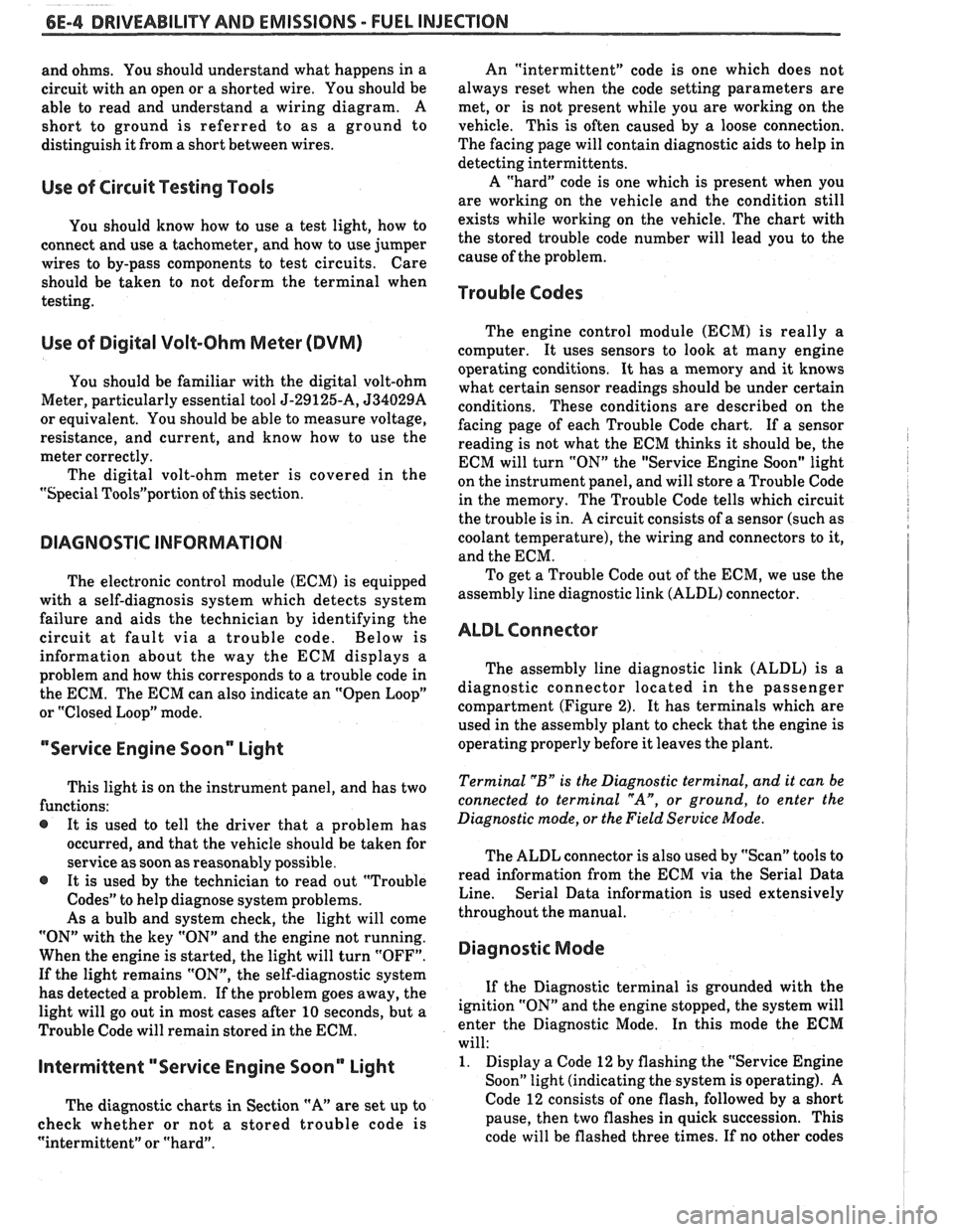
6E-4 DRIVEABILITY AND EMISSIONS - FUEL INJECnON
and ohms. You should understand what happens in a
circuit with an open or a shorted wire. You should be
able to read and understand a wiring diagram. A
short to ground
is referred to as a ground to
distinguish it from a short between wires.
Use of Circuit Testing Tools
You should know how to use a test light, how to
connect and use
a tachometer, and how to use jumper
wires to by-pass components to test circuits. Care
should be taken to not deform the terminal when
testing.
Use of Digital Volt-Ohm Meter (DVM)
You should be familiar with the digital volt-ohm
Meter, particularly essential tool J-29125-A,
J34029A
or equivalent. You should be able to measure voltage,
resistance, and current, and know how to use the
meter correctly.
The digital volt-ohm meter is covered in the
"Special
ToolsJ'portion of this section.
DIAGNOSTIC INFORMATION
The electronic control module (ECM) is equipped
with a self-diagnosis system which detects system
failure and aids the technician by identifying the
circuit at fault via a trouble code. Below is
information about the way the ECM displays a
problem and how this corresponds to a trouble code in
the ECM. The ECM can also indicate an "Open Loop"
or "Closed Loop" mode.
"'Service Engine Soonw Light
This light is on the instrument panel, and has two
functions:
@ It is used to tell the driver that a problem has
occurred, and that the vehicle should be taken for
service as soon as reasonably possible.
@ It is used by the technician to read out "Trouble
CodesJ' to help diagnose system problems.
As a bulb and system check, the light will come
"ON" with the key "ON" and the engine not running.
When the engine is started, the light will turn "OFF".
If the light remains "ONJ', the self-diagnostic system
has detected a problem. If the problem goes away, the
light will go out in most cases after 10 seconds, but a
Trouble Code will remain stored in the ECM.
Intermittent "Service Engine Soon" Light
The diagnostic charts in Section "A" are set up to
check whether or not a stored trouble code is
"intermittent" or "hard". An
"intermittent" code is one which does not
always reset when the code setting parameters are
met, or is not present while you are working on the
vehicle. This is often caused by
a loose connection.
The facing page will contain diagnostic aids to help in
detecting
intermittents.
A "hard" code is one which is present when you
are working on the vehicle and the condition still
exists while working on the vehicle. The chart with
the stored trouble code number will lead you to the
cause of the problem.
Trouble Codes
The engine control module (ECM) is really a
computer. It uses sensors to look at many engine
operating conditions. It has
a memory and it knows
what certain sensor readings should be under certain
conditions. These conditions are described on the
facing page of each Trouble Code chart. If a sensor
reading is not what the ECM thinks it should be, the
ECM will turn "ON" the "Service Engine Soon" light
on the instrument panel, and will store a Trouble Code
in the memory. The Trouble Code tells which circuit
the trouble is in. A circuit consists of a sensor (such as
coolant temperature), the wiring and connectors to it,
and the ECM.
i
To get a Trouble Code out of the ECM, we use the
assembly line diagnostic link (ALDL) connector.
!
ALDL Connector I
I
The assembly line diagnostic link (ALDL) is a
diagnostic connector located in the passenger
compartment (Figure 2). It has terminals which are
used in the assembly plant to check that the engine is
operating properly before it leaves the plant.
Terminal "B" is the Diagnostic terminal, and it can be
connected to terminal
"A", or ground, to enter the
Diagnostic mode, or the Field Service Mode.
The ALDL connector is also used by "ScanJ' tools to
read information from the ECM via the Serial Data
Line. Serial Data information
is used extensively
throughout the manual.
Diagnostic Mode
1
If the Diagnostic terminal is grounded with the
ignition "ON" and the engine stopped, the system will
enter the Diagnostic Mode. In this mode the ECM
will:
1. Display a Code 12 by flashing the "Service Engine
Soon" light (indicating the system is operating). A
Code 12 consists of one flash, followed by a short
pause, then two flashes in quick succession. This
code will be flashed three times. If no other codes
Page 1183 of 1825
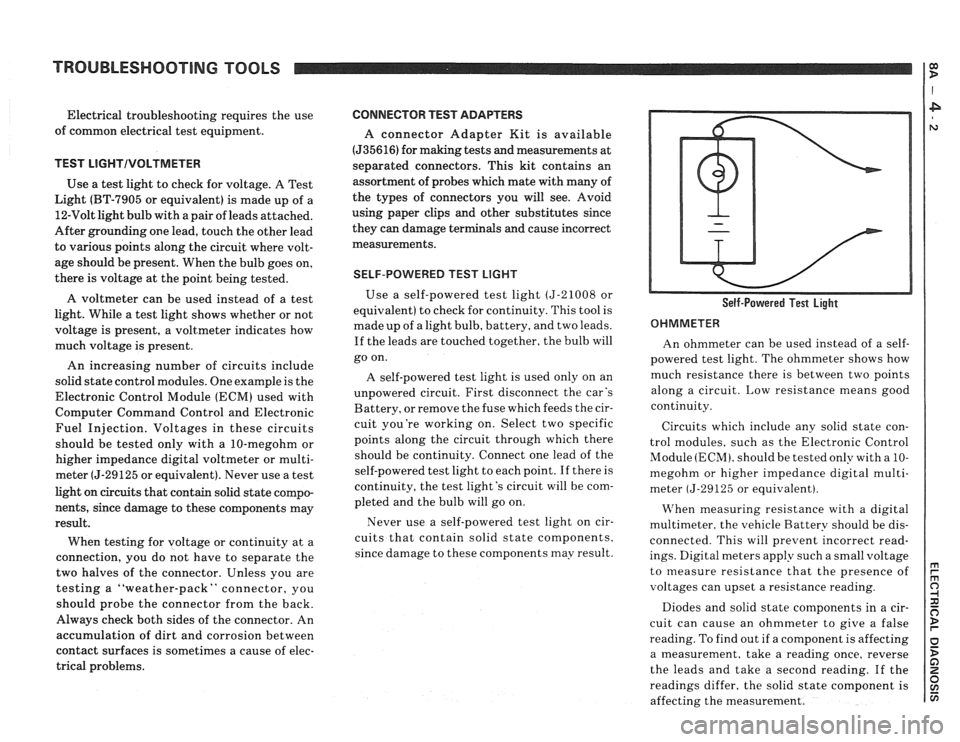
TROUBLESHOOT1NG TOOLS
Electrical troubleshooting requires the use
of common electrical test equipment.
TEST LIGHTIVOLTMETER
Use a test light to check for voltage. A Test
Light (BT-7905 or equivalent) is made up of a
12-Volt light bulb with apair of leads attached.
After grounding one lead, touch the other lead
to various points along the circuit where volt-
age should be present. When the bulb goes on,
there is voltage at the point being tested.
A voltmeter can be used instead of a test
light. While a test light shows whether or not
voltage is present, a voltmeter indicates how
much voltage is present.
An increasing number of circuits include
solid state control modules. One example is the
Electronic Control Module
(ECM) used with
Computer Command Control and Electronic
Fuel Injection. Voltages in these circuits
should be tested only with a 10-megohm or
higher impedance digital voltmeter or multi-
meter (5-29125 or equivalent). Never use a test
light on circuits that contain solid state compo-
nents, since damage to these components may
result.
When testing for voltage or continuity at a
connection, you do not have to separate the
two halves of the connector. Unless you are
testing a "weather-pack" connector, you
should probe the connector from the back.
Always check both sides of the connector. An
accumulation of dirt and corrosion between
contact surfaces is sometimes a cause of elec-
trical problems.
CONNECTOR TEST ADAPTERS
A connector Adapter Kit is available
(535616) for making tests and measurements at
separated connectors. This kit contains an
assortment of probes which mate with many of
the types of connectors you will see. Avoid
using paper clips and other substitutes since
they can damage terminals and cause incorrect
measurements.
SELF-POWERED TEST LIGHT
Use a self-powered test light (5-21008 or
equivalent) to check for continuity. This tool is
made up of a light bulb, battery, and two leads.
If the leads are touched together, the bulb will
go on.
A self-powered test light is used only on an
unpowered circuit. First disconnect the car's
Battery, or remove the fuse which feeds the cir-
cuit you're working on. Select two specific
points along the circuit through which there
should be continuity. Connect one lead of the
self-powered test light to each point. If there is
continuity, the test light's circuit will be com-
pleted and the bulb will go on.
Never use a self-powered test light on cir-
cuits that contain solid state components,
since damage to these components may result. Self-Powered Test Light
OHMMETER
An ohmmeter can be used instead of a self-
powered test light. The ohmmeter shows how
much resistance there is between two points
along a circuit. Low resistance means good
continuity.
Circuits which include any solid state con-
trol modules, such as the Electronic Control
Module
(ECM), should be tested only with a 10-
megohm or higher impedance digital multi-
meter
(5-29125 or equivalent).
VIThen measuring resistance with a digital
multimeter. the vehicle Battery should be dis-
connected. This will prevent incorrect read-
ings. Digital meters apply such a small voltage
to measure resistance that the presence of
voltages can upset a resistance reading.
Diodes and solid state components in a cir-
cuit can cause an ohmmeter to give a false
reading. To find out if a component is affecting
a measurement, take a reading once, reverse
the leads and take a second reading.
If the
readings differ, the solid state component is
affecting the measurement.
Page 1209 of 1825

POWER DISTRIBUTION
CIRCUIT OPERATION
Electrical power for the car is provided by the
Generator when the engine is running. The
schematic diagram shows how each circuit gets
its power. For more details about the Gener-
ator, and connections to the Battery and
Starter, see Starter and Charging System, Sec-
tion
8A-30.
The car's Power Distribution System con-
sists of Fusible Links, Fuses, Circuit Breakers,
the Light Switch and the Ignition Switch. Fusi-
ble Links are short pieces of wire to which they
supply power. They are covered with a special
high-temperature insulation. When conducting
a high current, the Fusible Link will melt and
stop current flow. They are designed to protect
the car's electrical system from electrical
shorts where it is not protected by the Circuit
Breakers and Fuses. See Fuse Block Details
and Light Switch Details for complete wiring to
the first component in each circuit.
The Ignition Switch has six positions, five of
which have detents. The BULB TEST position
is after the RUN position and just before the
START position. BULB TEST does not have a
detent. As shown in the schematic, circuits
which are supplied from the Ignition Switch are
On (Hot) for different switch positions. Indi-
vidual schematics show their fuses supplied
from headings such as "Not In Run. "The head-
ing corresponds to the Ignition Switch position
in which power is On.
Page 1334 of 1825
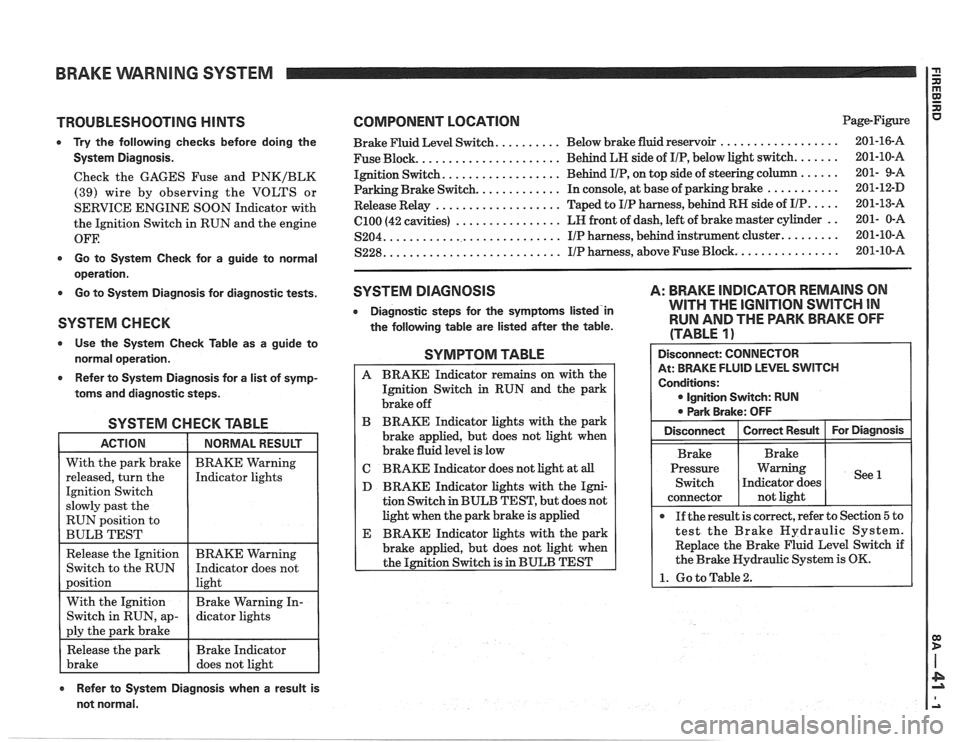
BRAKE VVARNlNG SYSTEM
TROUBLESHOOTING HINTS
0 Try the following checks before doing the
System Diagnosis.
Check the GAGES Fuse and PNKIBLK
(39) wire by observing the VOLTS or
SERVICE ENGINE SOON Indicator with
the Ignition Switch in RUN and the engine
OFF.
0 Go to System Check for a guide to normal
operation.
0 Go to System Diagnosis for diagnostic tests.
SYSTEM CHECK
Use the System Check Table as a guide to
normal operation.
e Refer to System Diagnosis for a list of symp-
toms and diagnostic steps.
SYSTEM CHECK TABLE
RUN position to
BULB TEST
COMPONENT LOCATION Page-Figure
.................. Brake Fluid Level Switch. ......... Below brake fluid reservoir 201-16-A
..................... Fuse Block. Behind
LH side of IIP, below light switch. ...... 201-10-A
................. Ignition Switch. Behind IIP, on
top side of steering column ...... 201- 9-A
Parking Brake Switch.
............ In console, at base of parking brake ........... 201-12-D
................... Release Relay Taped
to IIP harness, behind RH side of IIP. .... 201-13-A
................ (2100 (42 cavities) LR
front of dash, left of brake master cylinder .. 201- 0-A
........................... S204. IIP harness, behind instrument cluster. ........ 201-10-A
.......................... ............... S228. IIP harness, above Fuse Block. 201-10-A
SYSTEM DIAGNOSIS
0 Diagnostic steps for the symptorns listed'in
the following table are listed after the table.
A: BRAKE INDICATOR REMAINS ON
WITH THE
IGNITION SWITCH IN
RUN AND THE PARK BRAKE OFF
(TABLE
1)
SYMPTOM TABLE
A BRAKE Indicator remains on with the
Ignition Switch
in RUN and the park
brake off
B BRAKE Indicator lights with the park
brake applied, but does not light when
brake fluid level is low
C BRAKE Indicator does not light at all
D BRAKE Indicator lights with the Igni-
tion Switch in BULB TEST, but does not
light when the park brake is applied
E BRAKE Indicator lights with the park
brake applied, but does not light when
the Ignition Switch is in BULB TEST
Refer to System Diagnosis when a result is
not normal. Disconnect:
CONNECTOR
At: BRAKE FLUID LEVEL SWITCH
Conditions:
0 Ignition Switch: RUN
0 Park Brake: OFF
Pressure Warning
If the result is correct, refer to Section
5 to
test the Brake Hydraulic System.
Replace the Brake Fluid Level Switch if
the Brake Hydraulic System is OK.
1. Go to Table2.
Page 1335 of 1825

BRAKE WARNING SYSTEM I:
A: BRAKE INDICATOR REMAlNS ON
WITH THE lGNlTlON SWITCH IN
RUN AND THE PARK BRAKE OFF
(TABLE
2)
Disconnect: CONNECTOR I
At: PARKING BRAKE SWITCH
Conditions:
0 lgnition Switch: RUN
0 Park Brake: OFF
Disconnect
I Correct Result I For Diagnosis
Parking Brake
connector not light
If the result is correct, checklreplace the
Parking Brake Switch
1. Check the Ignition Switch for a short to
ground in the RUN position. If Ignition
Switch is good, check TANIWHT
(33)
wires for a short to mound.
B: BRAKE INDICATOR LIGHTS WITH 6: BRAKE INDICATOR DOES NOT
THE PARK BRAKE APPLIED, BUT
LIGHT AT ALL
DOES NOT
LIGHT WHEN BRAKE
FLUID LEVEL IS LOW
1. Check Indicator bulb, TANIWHT (33)
Connect: FUSED JUMPER
At: BRAKE FLUID LEVEL SWITCH
CONNECTOR
Conditions:
lgnition Switch: RUN
0 Park Brake: OFF
Connect
Between
Brake Fluid
Level Switch
Connector
&
Ground
If the result is correct, checklreplace the
Brake Fluid Level Switch.
1. Check TANIWHT (33) wire for an open.
Correct Result
Brake
Warning
Indicator lights
For Diagnosis
See 1
Page 1336 of 1825
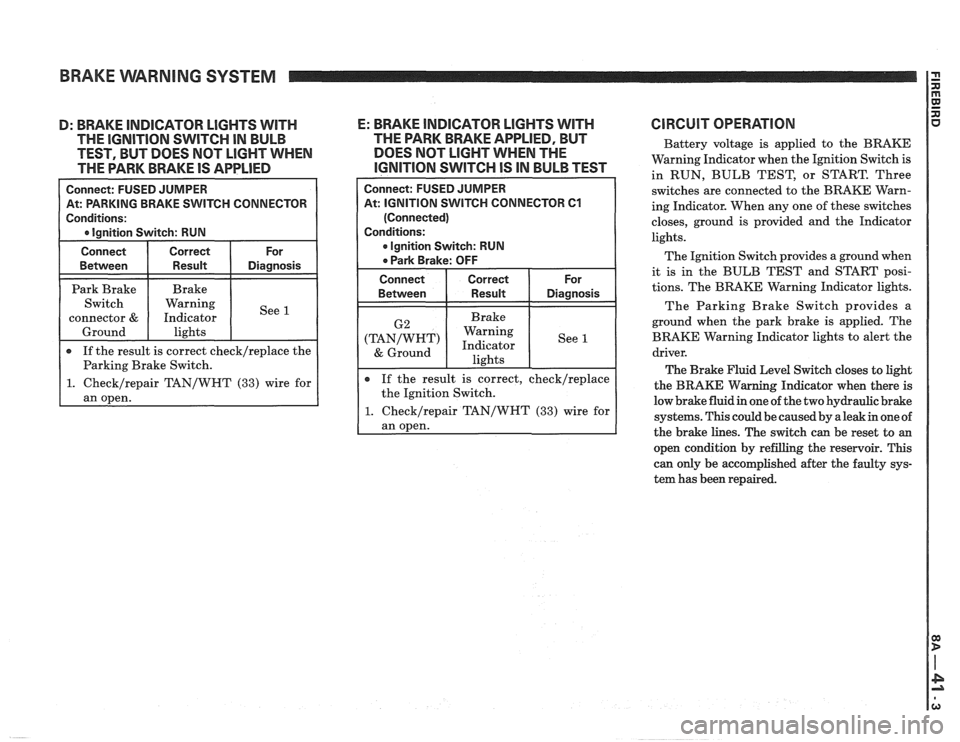
BRAKE WARNING SYSTEM
H CONNECTOR
epair TAN/WHT (33) wire for
D: BRAKE INDICATOR LIGHTS WITH E: BRAKE INDICATOR LlGHTS WITH
THE IGNITION SWITCH IN BULB THE
PARK BRAKE APPLIED, BUT
TEST, BUT DOES NOT
LIGHT WHEN DOES
NOT LIGHT WHEN THE
THE PARK BRAKE IS
APPLIED IGNITION SWITCH IS IN BULB TEST
At: IGNITION SWITCH CONNECTOR 61
If the result is correct, check/replace
the Ignition Switch.
1. Checklrepair TAN/WHT (33) wire for
ClRCUlT OPERATION
Battery voltage is applied to the BRAKE
Warning Indicator when the Ignition Switch is
in RUN, BULB TEST, or START. Three
switches are connected to the BRAKE Warn-
ing Indicator. When any one of these switches
closes, ground is provided and the Indicator
lights.
The Ignition Switch provides a ground when
it is in the BULB TEST and START posi-
tions. The BRAKE Warning Indicator lights.
The Parking Brake Switch provides a
ground when the park brake is applied. The
BRAKE Warning Indicator lights to alert the
driver.
The Brake Fluid Level Switch closes to light
the
BRAKE Warning Indicator when there is
low brake fluid in one of the two hydraulic brake
systems. This could be caused by a leak in one of
the brake lines. The switch can be reset to
an
open condition by refilling the reservoir. This
can only be accomplished after the faulty sys-
tem has been repaired.
Page 1344 of 1825
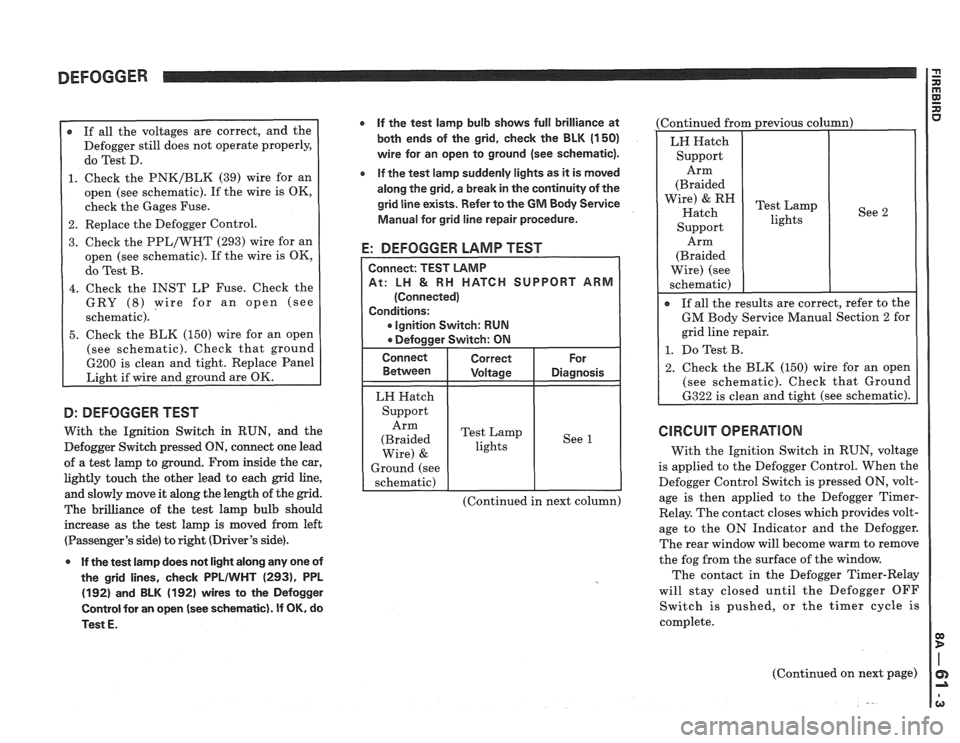
DEFOGGER
r If all the voltages are correct, and the
Defogger still does not operate properly,
do Test D.
1. Check the PNK/BLK (39) wire for an
open (see schematic). If the wire is OK,
check the Gages Fuse.
2. Replace the Defogger Control.
3. Check the PPL/WHT (293) wire for an
open (see schematic). If the wire is OK,
do Test B.
4. Check the INST LP Fuse. Check the
GRY
(8) wire for an open (see
schematic).
5. Check the BLK (150) wire for an open
(see schematic). Check that ground
6200 is clean and tight. Replace Panel
Light if wire and ground are OK.
D: DEFOGGER TEST
With the Ignition Switch in RUN, and the
Defogger Switch pressed
ON, connect one lead
of a test lamp to ground. From inside the car,
lightly touch the other lead to each grid line,
and slowly move it along the length of the grid.
The brilliance of the test lamp bulb should
increase as the test lamp is moved from left
(Passenger's side) to right (Driver's side).
0 If the test lamp does not light along any one of
the grid lines, check
PPLIWHT (2931, PPL
(192) and BLK (192) wires to the Defogger
Control for an open
(see schematic). If OK, do
Test
E.
If the test lamp bulb shows full brilliance at
both ends of the grid, check the BLK
(1 50)
wire for an open to ground (see schematic).
e If the test lamp suddenly lights as it is moved
along the grid, a break in the continuity of the
grid line exists. Refer to the
GM Body Service
Manual for grid line repair procedure.
E: DEFOGGER LAMP TEST
CH SUPPORT ARM
Ignition Switch: RUN
LH Hatch
Support Arm
(Braided Test
Lamp
lights See
1
Wire) &
Ground
(see
schematic)
(Continued in next column) (Continued
from previous column)
See 2
Arm
(Braided
Wire) (see
schematic)
I
If all the results are correct, refer to the
GM Body Service Manual Section 2 for
grid line repair.
1. Do Test B.
2. Check the BLK (150) wire for an open
(see schematic). Check that Ground
6322 is clean and tight (see schematic).
CIRCUIT OPERATION
With the Ignition Switch in RUN, voltage
is applied to the Defogger Control. When the
Defogger Control Switch is pressed ON, volt-
age is then applied to the Defogger
Timer-
Relay. The contact closes which provides volt-
age to the ON Indicator and the Defogger.
The rear window will become warm to remove
the fog from the surface of the window.
The contact in the Defogger Timer-Relay
will stay closed until the Defogger OFF
Switch is pushed, or the timer cycle is
complete.
(Continued on next page)